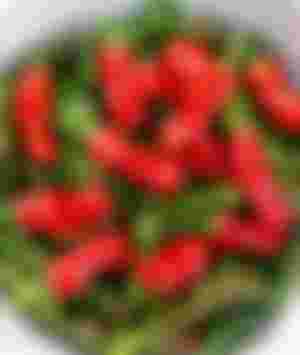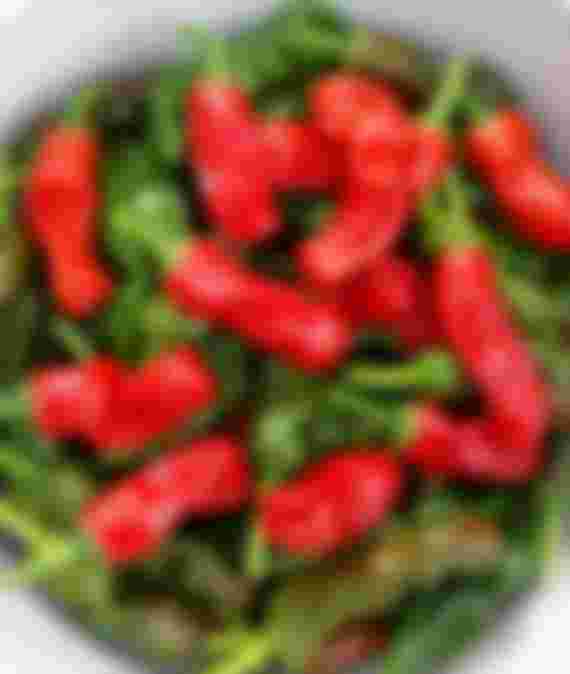Peter Pepper or Peter chili peppers are irregularly shaped pods, averaging 7 to 15 centimeters in length and 2 to 5 centimeters in diameter, and have a wrinkled, cylindrical shape ending with a rounded, blunt tip accented with a cleft. The pods may be smooth or covered in many folds and dimples, and the skin is glossy, waxy, and firm, ripening from green to bright red when mature.

Peter chili peppers are an excellent source of vitamins A and C, which are antioxidants that can help boost the immune system and repair damage within the skin. The peppers also contain capsaicin, which is the chemical compound that triggers the brain to feel the sensation of spice or heat. Capsaicin has been shown to have antioxidant and anti-inflammatory properties.
Peter chili peppers are available in the late summer through fall.
Peter chili peppers, botanically classified as Capsicum annuum, are an heirloom variety belonging to the Solanaceae or nightshade family. Considered to be a rare, specialty pepper developed in the United States, Peter chili peppers earned their name from their provocative, phallic shape.
The peppers are primarily considered to be an ornamental variety, valued by home gardeners for their conversation-starting appearance, and there are three main varieties ranging in color from orange, red, to yellow. In addition to their novelty, Peter chile peppers are also a moderately hot variety, ranging 5,000-30,000 SHU ( Scoville Heat Units) on the Scoville scale, and can be utilized in salsas, hot sauces, and marinades.
What's the origin of Peter Chili Pepper?
Though exact origin is unknown, Peter chili peppers are believed to be native to the southern United States, especially to Texas and Louisiana, and have been documented since the 1700s. The peppers were made popular by H.W. Alfrey, a Tennessee man who started his own seed company known as Alfrey Seeds around the peculiar pepper. Alfrey spent decades cultivating Peter chili peppers for taste and shape, and he is also credited with naming the variety.
In Lafayette, Louisiana, Papa Jeabert’s is a spice company that specializes in growing Peter chile peppers for use in their Cajun seasoning called “Spice de Terre,” translating to “spice of the earth.” The company is credited with being one of the only commercial Peter chile pepper farms.
Today Peter chili pepper seeds are considered a specialty pepper that is rarely found in stores and is most often found through online seed catalogs for home gardening. The peppers may also be found through small farms at local markets in the United States, Mexico, and sometimes in South Korea.
Where to apply Peter Chili Peppers?
Peter chili peppers are best suited for both raw and cooked applications such as roasting, sautéing, stir-frying, or baking.
The peppers can be diced into hot sauces, marinades, dressings, and salsas, or they can be incorporated into soups, pasta sauces, and stews.
Peter chili peppers can also be roasted and layered in sandwiches, sliced and stirred into casseroles, or combined with cooked meats for additional spice. It is important to note that the high levels of capsaicin may cause irritation to the skin and eyes, so protective wear such as gloves and goggles are recommended to be worn when preparing the peppers.
In addition to fresh and cooked applications, Peter chili peppers can be dried and ground into a powder for use as a spice.
The peppers can also be used as a substitute for serrano peppers in recipes.
Peter chili peppers pair well with fruits such as watermelon, mango, avocado, and peach, legumes, tomatillos, tomatoes, onions, garlic, meats such as beef, pork, and poultry, eggs, and herbs such as cilantro, oregano, and thyme.
Fresh peppers will keep 1-2 weeks when loosely stored whole and unwashed in a paper or plastic bag in the refrigerator
I have read somewhere that this one has other natural medical value also, addition to its Vitamin A and C high content. Will add to this article once I have found it again.
So, in despite of it's peculiar appearance, Peter Chili Pepper is really a wonderful one!
Happy reading!
Thank you. ;)
